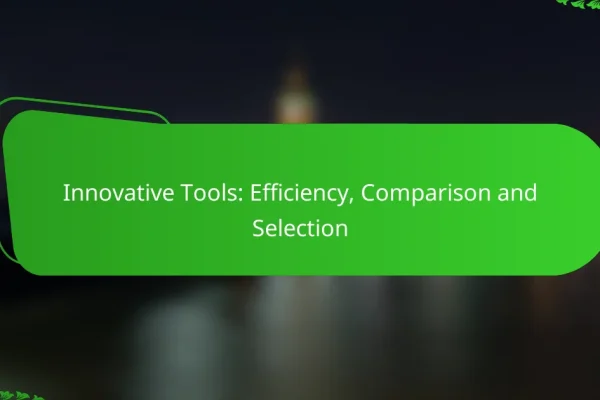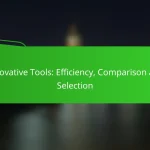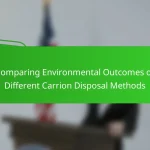What technologies are used in carrion management in the UK?
In the UK, various technologies are employed in carrion management to enhance efficiency and effectiveness. These include drone surveillance, automated collection systems, mobile reporting apps, and biodegradable disposal solutions, each playing a crucial role in managing animal carcasses responsibly.
Drone surveillance for carcass detection
Drone surveillance is increasingly used for detecting carcasses in remote or hard-to-reach areas. Equipped with high-resolution cameras and thermal imaging, drones can quickly survey large landscapes, identifying carcasses that may pose health risks or attract scavengers.
This technology allows for rapid response times, reducing the time carcasses remain in the environment. Operators must ensure compliance with local regulations regarding drone flights, particularly in populated areas or near wildlife reserves.
Automated collection systems
Automated collection systems streamline the process of removing animal carcasses from various environments. These systems can include robotic vehicles or conveyor belts that transport carcasses to designated disposal sites, minimizing human contact and exposure to potential pathogens.
Implementing these systems can significantly reduce labor costs and improve response times. However, initial setup costs can be high, and ongoing maintenance is essential to ensure reliability and efficiency.
Mobile apps for reporting
Mobile apps facilitate the reporting of found carcasses by the public and professionals alike. Users can quickly submit details about the location and condition of a carcass, which helps local authorities respond promptly.
These apps often include features such as GPS tagging and photo uploads, enhancing the accuracy of reports. Encouraging community engagement through these platforms can lead to more effective management of carrion and better public health outcomes.
Biodegradable disposal solutions
Biodegradable disposal solutions, such as composting and anaerobic digestion, are environmentally friendly methods for managing carcasses. These processes break down organic matter naturally, reducing landfill use and minimizing greenhouse gas emissions.
In the UK, regulations support the use of such methods, provided they meet specific health and safety standards. Implementing these solutions can be cost-effective in the long run, but they require proper infrastructure and public awareness to be successful.
How does technology improve efficiency in carrion management?
Technology enhances efficiency in carrion management by streamlining processes, enabling quicker responses, and improving communication among teams. By leveraging tools such as real-time data tracking and mobile applications, organizations can manage carcass disposal more effectively and comply with local regulations.
Real-time data tracking
Real-time data tracking allows teams to monitor carcass locations and conditions instantly. This technology utilizes GPS and IoT sensors to provide accurate updates, which helps in planning timely interventions.
For example, a system that tracks the temperature and decomposition stage of a carcass can alert teams when immediate action is required. This reduces the risk of environmental contamination and ensures compliance with health regulations.
Reduced response times
By implementing technology, organizations can significantly reduce response times to carcass reports. Automated alerts and streamlined reporting systems enable teams to act swiftly, often within minutes of receiving a notification.
This rapid response is crucial in urban areas where delays can lead to public health risks. Using mobile apps, field teams can receive real-time updates and directions, ensuring they reach the site quickly and efficiently.
Enhanced communication among teams
Technology fosters better communication among teams involved in carrion management. Tools like collaborative platforms and messaging apps ensure that all team members are informed and can coordinate their efforts effectively.
For instance, a centralized communication system can facilitate updates on carcass status, disposal schedules, and regulatory compliance. This reduces miscommunication and helps maintain a clear chain of command, which is vital for efficient operations.
What are the costs associated with implementing technology in carrion management?
The costs of implementing technology in carrion management can vary significantly based on the type of technology used and the scale of operations. Key expenses include initial investments for equipment, ongoing maintenance, and training costs for personnel.
Initial investment for equipment
The initial investment for equipment in carrion management can range from a few thousand to several tens of thousands of dollars, depending on the technology chosen. Options may include automated collection systems, drones for monitoring, or specialized vehicles for transport.
When selecting equipment, consider the durability and efficiency of the technology, as well as any regulatory compliance requirements that may apply in your region. Investing in high-quality equipment can reduce long-term costs by minimizing repairs and replacements.
Ongoing maintenance expenses
Ongoing maintenance expenses are crucial to consider when implementing technology in carrion management. These costs typically include routine servicing, software updates, and potential repairs, which can add up to several hundred to a few thousand dollars annually.
To manage these expenses effectively, establish a maintenance schedule and allocate a budget for unexpected repairs. Regular maintenance can extend the lifespan of your equipment and ensure optimal performance.
Training costs for personnel
Training costs for personnel involved in carrion management technology can vary widely, often ranging from a few hundred to several thousand dollars per employee. This training is essential to ensure that staff can operate the technology safely and efficiently.
Consider offering ongoing training sessions and resources to keep personnel updated on new technologies and best practices. Investing in comprehensive training can lead to improved efficiency and reduced errors in operations.
What are the regulatory considerations for using technology in carrion management?
Regulatory considerations for using technology in carrion management include compliance with environmental laws and adherence to data privacy regulations. These factors ensure that the implementation of technology does not harm the ecosystem and respects individuals’ privacy rights.
Compliance with environmental regulations
When employing technology for carrion management, it is essential to comply with local environmental regulations. This may involve obtaining permits for the use of specific technologies, such as drones or automated tracking systems, which could impact wildlife or natural habitats.
For example, in many regions, there are strict guidelines on how to dispose of animal remains to prevent contamination of soil and water sources. Familiarizing yourself with these regulations can help avoid legal penalties and promote sustainable practices.
Data privacy laws for tracking systems
Data privacy laws play a critical role in the implementation of tracking systems for carrion management. These laws govern how personal data is collected, stored, and used, especially if the technology involves monitoring individuals or properties.
Organizations must ensure that any data collected through tracking systems complies with regulations such as the General Data Protection Regulation (GDPR) in the EU or the California Consumer Privacy Act (CCPA) in the U.S. This includes obtaining consent from individuals before data collection and implementing robust security measures to protect sensitive information.
What are the best practices for selecting technology solutions in carrion management?
Best practices for selecting technology solutions in carrion management involve understanding local needs, evaluating vendor reliability, and ensuring scalability. These factors help organizations choose effective tools that align with their operational requirements and environmental conditions.
Assessing specific needs of local areas
Identifying the specific needs of local areas is crucial for effective carrion management. Factors such as population density, types of wildlife, and local regulations can significantly influence the choice of technology. For example, urban areas may require faster response times and more sophisticated tracking systems compared to rural settings.
Conducting a needs assessment can involve surveys or consultations with local stakeholders, including wildlife agencies and community members. This helps in tailoring solutions that address the unique challenges faced in each locality.
Evaluating vendor reliability
Vendor reliability is a key consideration when selecting technology solutions for carrion management. Look for vendors with a proven track record in the industry, positive customer reviews, and transparent service agreements. Reliable vendors should also provide ongoing support and maintenance to ensure the technology remains effective over time.
Consider requesting case studies or references from potential vendors to assess their experience in similar environments. This can provide insights into their ability to deliver on promises and adapt to unforeseen challenges.
Considering scalability of solutions
Scalability is essential for technology solutions in carrion management, as needs may change over time. Choose systems that can easily expand or adapt to increasing demands, whether due to population growth or changes in wildlife patterns. For instance, a software platform that can integrate additional sensors or data sources as needed is advantageous.
When evaluating scalability, consider both the technical aspects and the financial implications. Ensure that the costs associated with scaling up are manageable and that the solution can grow without requiring a complete overhaul.
How can technology enhance public awareness in carrion management?
Technology can significantly boost public awareness in carrion management by providing accessible information and facilitating community involvement. Through digital platforms and mobile applications, residents can report carrion sightings, receive updates, and learn best practices for handling such situations.
Community engagement platforms
Community engagement platforms serve as vital tools for enhancing public participation in carrion management. These platforms allow users to share information about carrion locations, report issues, and connect with local authorities. For example, a dedicated website or social media group can facilitate real-time communication, enabling quicker responses to carrion-related incidents.
To maximize effectiveness, these platforms should be user-friendly and encourage active participation. Regular updates and community events can keep the public informed and engaged, fostering a sense of responsibility towards local environmental health.
Educational outreach through apps
Mobile applications focused on educational outreach can empower users with knowledge about carrion management. These apps can provide guidelines on how to report carrion, identify potential health risks, and understand local regulations regarding dead animal disposal. Features like push notifications can alert users to nearby incidents or community clean-up events.
When developing these apps, consider incorporating interactive elements such as quizzes or gamified learning experiences to enhance user engagement. Additionally, providing multilingual support can ensure that diverse communities are included in the educational outreach efforts.






